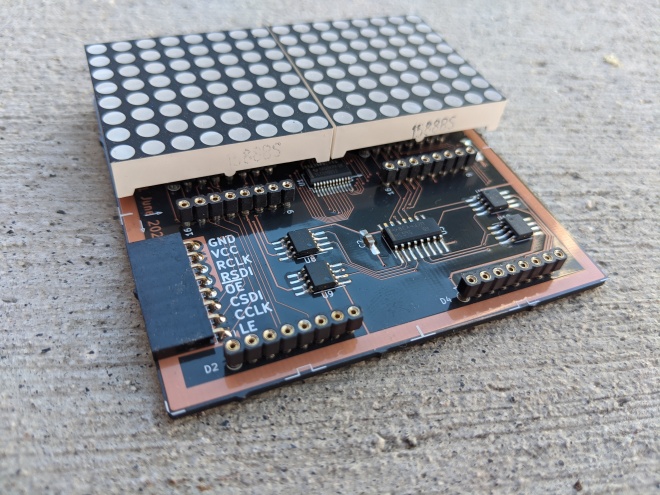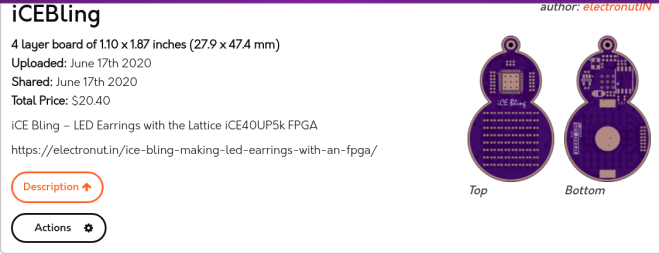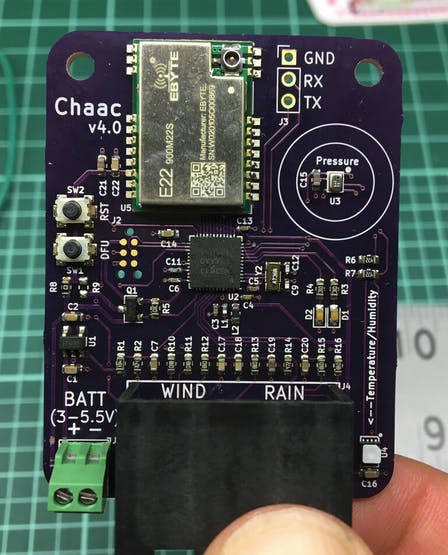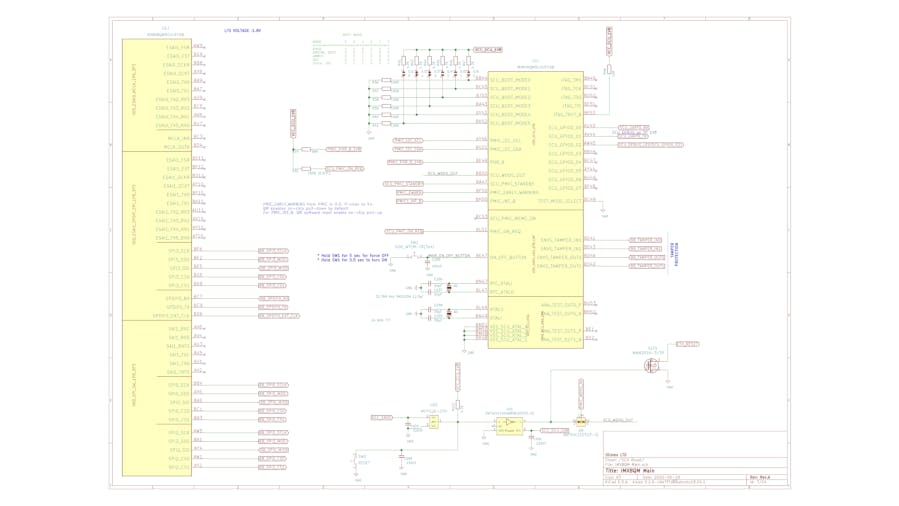For a previous project I explored what it would take to create a text marquee on an 8×8 LED matrix display without microcontroller, using only 7400 chips, an old EEPROM and breadboard components. Matrix Displays I was interested in using an LED matrix display and I picked up some cheap 8×8 ones on Amazon. medium.com That worked, but 8×8 is very small to do anything interesting and so I wanted to give it another go, create a larger 16×16 panel, design a custom PCB and ultimately hook it up to a microcontroller this time to write some games for it.
Month: July 2020
iCE Bling: Beautiful LED Earrings with Lattice iCE40 FPGA
Mahesh Venkitachalam has created wondeful LED Earrings with the Lattice iCE40UP5k FPGA and shared the project on our website:
Find out more about the project in this blog post:
iCE Bling FPGA – Beautiful LED Earrings with Lattice iCE40
It’s the same story every year. At the horizon is a loved one’s birthday, or an anniversary, and I want to make them something special. Buying something won’t do. Oh no, I have to design and build it myself. I would then start with a simple idea, and then complicate it progressively to the point where it would take several anniversaries to finish the project.
This time, I wanted to build a pair of earrings for my wife’s birthday. Since I am learning about FPGAs these days, I wanted to incorporate one into the design. Having gotten older and wiser, I decided to enlist help early on. I would focus on the overall design and the programming part, and leave the PCB design and assembly to my trusted friend and engineer Siva.
Jerry Lawson: Father of the Video Game Cartridge
Jerry Lawson was an engineer from New York who had arrived at Fairchild Semiconductor in 1970 after having worked at various companies in the defense electronics industry. Working as part of their customer engagement effort, he achieved prominence in the company by revolutionising the point of contact with the customer using an RV (yes, a camping vehicle) converted as a demonstration lab for Fairchild products. He was lucky enough to be in the right place at the right time to be a member of the famous Homebrew Computer Club, cradle of so much of the later microcomputer industry, which put him at the center of a web of contacts covering the games business as it was in the early 1970s.
Though his employer was not involved in gaming, Jerry got his start in that field as a side project. When his friend Allan Alcorn installed the first Pong machine in Andy Capp’s Tavern it suffered from customers interfering with its coin mechanism to score free plays, so Jerry produced a game cabinet of his own called Demolition Derby that had a more robust system. This led to Fairchild Semiconductor International offering him the chance to start their new video game division, and the road to the Channel F was laid.
[..]
There are many names from the annals of computing history who roll off the tongue. People such as Jobs and Wozniak, Bushnell, Dabney, Sinclair, Miyamoto, or Miner. We should also add Jerry Lawson to that list, as his vision to make one console and sell multiple games, done inexpensively with the use of the PCB edge connector, set the standard for decades to come.
via Jerry Lawson And The Fairchild Channel F; Father of the Video Game Cartridge — Hackaday
RC2014 backplane constructed with flex PCB
We were exited to see this use of a flex PCB to create a backplane for the RC2014:
RC2014 is a simple 8 bit Z80 based modular computer originally built to run Microsoft BASIC. It is inspired by the home built computers of the late 70s and computer revolution of the early 80s. It is not a clone of anything specific, but there are suggestions of the ZX81, UK101, S100, Superboard II and Apple I in here. It nominally has 8K ROM, 32K RAM, runs at 7.3728MHz and communicates over serial at 115,200 baud.
Alvaro Prieto’s Chaac Weather Station
From Gareth Halfacree on Hackster:
Alvaro Prieto Walks Through a Year of Chaac Weather Station Designs, Upgrades, and Enhancements
Alvaro Prieto has published a write-up of his latest weather station board, the Chaac v4.0, which adds Bluetooth connectivity to his existing XBee-based design.
The Chaac project has been ongoing for some time: Prieto documented his original efforts to build a weather station a year ago, walking through a range of improvements that went from an nRF52-based Bluetooth Low Energy prototype through to a breakout board for the Nucleo development board, and the integrated Chaac board versions 1.0 through 1.2 — the latter adding in solar panel voltage monitoring.
In the year since, Prieto has been working on upgrading the Chaac design — and has gathered all the improvements into a single write-up, beginning with the Chaac v2.0 which combined the existing XBee-based communication system with an nRF52811 for Bluetooth connectivity.
Printed It: Print-in-Place PCB Gripper
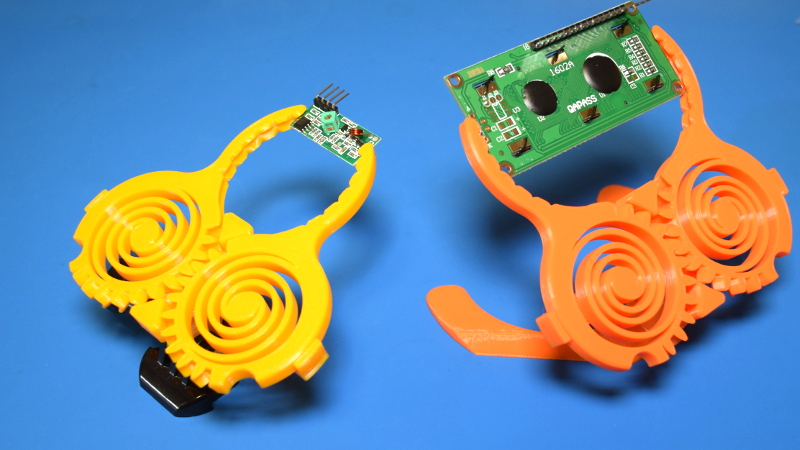
The goal of Printed It is to showcase creations that truly embrace the possibilities offered by desktop 3D printing. The most obvious examples are designs that can be printed quickly and cheaply enough that they’re a valid alternative to commercially available products. But as previous entries into the series have shown, there are also technical considerations. […]
Printed It: Print-in-Place PCB Gripper
Roboticist Grant Imahara has passed away
We are saddened to read the news today that Grant Imahara has passed away. Mike Szczys writes more on Hackaday:
We awake this morning to sad news of the premature passing of Grant Imahara at the age of 49 due to a brain aneurysm. Grant was best known for his role on the wildly popular Mythbusters television show on which he starred and built test apparatus for seasons three through twelve. He landed this role because he was a badass hardware hacker as much as he was an on-camera personality.
Grant received his degree in electrical engineering from USC in 1993 and landed a job with Lucasfilm, finding his way onto the Industrial Light and Magic team to work on blockbuster films like the Star Wars prequels (R2-D2 among other practical effects) and sequels to Terminator and The Matrix. Joining the Mythbusters team in 2005 was something of a move to rapid prototyping. Each of the 22-minute episodes operated on a 10-day build and a film cycle in which Grant was often tasked with designing and fabricating test rigs for repeatable testing with tightly controlled parameters.
After leaving the show, Grant pursued several acting opportunities, including the Kickstarter funded web series Star Trek Continues which we reported on back in 2013. But he did return to the myth busting genre with one season of The White Rabbit Project on Netflix. One of the most genuinely geeky appearances Grant made was on an early season of Battlebots where his robot ‘Deadblow’ sported a wicked spiked hammer. Video of his appearance in the quarter-finals is like a time-capsule in hacker history and guaranteed to bring a smile to your face.
Grant Imahara’s legacy is his advocacy of science and engineering. He was a role model who week after week proved that questioning how things work, and testing a hypothesis to find answers is both possible and awesome. At times he did so by celebrating destructive force in the machines and apparatus he built. But it was always done with observance of safety precautions and with a purpose in mind (well, perhaps with the exception of the Battlebots). His message was that robots and engineering are cool, that being a geek means you know what the heck you’re doing, and that we can entertain ourselves through creating. His message lives on through countless kids who have grown up to join engineering teams throughout the world.
Grant was the headliner at the first Hackaday Superconference in San Francisco back in 2015. I’ve embedded the fireside chat below where you can hear in his own words what inspired Grant, along with numerous stories from throughout his life.
via Roboticist Grant Imahara of Mythbusters Fame Dies of Aneurysm at Age 49 — Hackaday
AtomSoft uses flex for tiny DimeDuino
From the AtomSoftTech blog:
This time around i give you the DimeDuino. Its a Flex PCB based which utilizes the ATMEGA328P. Using this MCU allows for the installation of the Arduino bootloader. Hence the Duino in the name. These will come pre-programmed with the bootloader. One portion of the circle is just for programming. There is a GND, VCC,RXI, TXO and DTR & RST depending on your programmer.
As soon as its available ill post it here and on Twitter.
Specs:
- Atmega328 running at 3.3v/8MHz or 5v/16MHz
- Power LED (Green)
- User LED (D13– Color may vary but mainly Blue)
- Reset Button
- 3.3v(AP2112K) or 5v (AP7335A) Linear step down
- Flash 32KB (2KB is Bootloader)
- SRAM 2KB
- EEPROM 1KB
- 20 I/O Pins (A6 & A7 are not used here. Input Only anyway)
- 1 UART D0 (RX) and D1 (TX)
- 1 SPI D10 (SS), D11 (MOSI), D12 (MISO), D13 (SCK)
- 1 I2C A4 (SDA) and A5 (SCL)
- 6 PWM D3, D5, D6, D9, D10, and D11
- 14 I/O D0-D13
Tablet Oscilloscope Claims 100 MHz, But Is It?
[LearnElectronics] was skeptical of the 100 MHz claim and it looks like it is more like a 30 MHz analog bandwidth. Despite that, it does seem like a pretty capable 30 MHz scope in a very handy form factor and a very cheap price: as little as $120 or so, depending on where you shop.
via Tablet Oscilloscope Claims 100 MHz, But Is It? — Hackaday
Olimex designing powerful Linux board with KiCad
Gareth Halfacree writes on Hackster about Olimex’s new project:
Olimex’s Tukhla, Built Around the i.MX8QuadMax, Targets Open-Hardware Linux Power Users
Bulgarian open-hardware specialist Olimex has revealed details of what it describes as its “most complex OSHW board yet:” an NXP iMX8QuadMax-based single-board computer dubbed the Tukhla.
“[A] company from EU which values the OSHW [Open Source Hardware] recognized the absence of high-end open source Linux board and asked us to design one,” Olimex’s Tsvetan Usunov explains. “They offered to cover all associated design costs. They specially requested this to be not yet another [Rockchip] RK3399 board, but based on SoC with proper documentation and software support. NXP’s high end iMX8QuadMax matched their requirements perfectly.”
“Currently all powerful Cortex-A72 comes from Chinese or Korean origin and are always closed projects, the only published info in best case is PDF schematic which can’t be verified i.e. the final product may or may not match what they publish. The popular Raspberry Pi goes even further and their ‘schematics’ are just connector diagrams.”

The Tukhla, by contrast, will be a fully open design, Usunov promises — built in the open source KiCad electronic design automation (EDA) package. Aside from the iMX8 SoC itself — which includes two Arm Cortex-A72 cores, four Cortex-A53 cores, two Cortex-M4F cores, and a quad-core graphics processor with 32 OpenGL ES 3.2 and Vulkan compatible compute units — the board will include up to 16GB of LPDDR4 memory, microSD support, eMMC and QSPI flash storage, a SATA connector, two single-lane PCI Express connectors with NVMe support, HDMI input and output, USB 2.0 OTG and USB 3.0 Host support, two gigabit Ethernet ports, and two MIPI CSI camera connectors.

